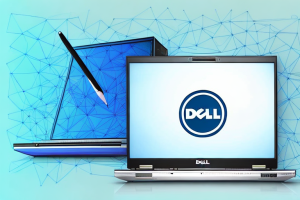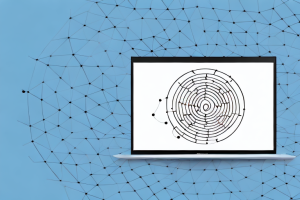How to troubleshoot a Dell XPS 13 not turning on
9 min read
A dell xps 13 laptop with a power cord plugged in
Dell XPS 13 is a popular and well-regarded laptop model. However, even the best laptops can encounter problems. If you’ve encountered an issue where your Dell XPS 13 won’t turn on, you’re not alone. In this article, we’ll explore the basic troubleshooting steps, reasons behind this problem, and share some tips for resolving the issue.
Basic troubleshooting steps for a Dell XPS 13 not turning on
Before diving into more complex solutions, it’s essential to run through the basic troubleshooting steps. Make sure your laptop battery is charged. Try disconnecting all the external devices, including USB drives, external hard drives, and other peripherals. Remove the battery and check its contacts. If you have a spare battery, try replacing it and see if the issue persists. Once you’ve exhausted these basic steps, move on to the more complex solutions.
If the basic troubleshooting steps don’t work, try resetting the laptop’s BIOS. To do this, turn off the laptop and unplug it from the power source. Then, press and hold the power button for 30 seconds. After that, plug the laptop back in and turn it on. If this doesn’t work, you may need to replace the laptop’s power adapter or charger.
If none of the above solutions work, it’s possible that there’s a hardware issue with your laptop. In this case, it’s best to contact Dell’s customer support or take your laptop to a professional technician for repair. Attempting to fix a hardware issue on your own can cause further damage to your laptop and may void your warranty.
Reasons why your Dell XPS 13 won’t turn on
There can be several reasons why your Dell XPS 13 won’t turn on, including software and hardware issues. In some cases, the power adapter might be faulty or the BIOS settings get corrupted. In other cases, a defective hard drive, RAM, or motherboard can cause the issue. Errors in Windows or Linux operating systems can also contribute to the problem.
Another possible reason why your Dell XPS 13 won’t turn on is a drained battery. If you have been using your laptop extensively without charging it, the battery may have run out of power. In this case, you can try connecting the power adapter and letting the laptop charge for a while before attempting to turn it on.
Additionally, physical damage to the laptop can also prevent it from turning on. If you have dropped your laptop or spilled liquid on it, the internal components may have been damaged, causing the issue. In such cases, it is recommended to take your laptop to a professional technician for repair.
The role of the power adapter in a Dell XPS 13 not turning on
The power adapter is a crucial component in a laptop. Its primary purpose is to supply power to the laptop. It’s essential to check if the adapter’s power cord is plugged firmly into the socket and laptop. Try using another power outlet to charge your laptop. You can also try another power adapter with similar wattage to check if the original adapter is faulty.
Another reason why a Dell XPS 13 may not turn on is due to a faulty battery. If the battery is not holding a charge, the laptop may not turn on even if it’s plugged in. You can try removing the battery and plugging in the power adapter to see if the laptop turns on. If it does, then the battery needs to be replaced.
In some cases, the issue may not be with the power adapter or battery, but with the laptop’s hardware. If the laptop has suffered physical damage or has a hardware malfunction, it may not turn on. In such cases, it’s best to take the laptop to a professional technician who can diagnose and fix the issue.
Tips for checking the battery of your Dell XPS 13 when it doesn’t turn on
If you’ve isolated the issue to the battery, try removing it and putting it back in. Check if the battery contacts are dirty and clean them with a cotton swab dipped in rubbing alcohol. You can also try charging the battery using an external battery charger. If the battery still doesn’t charge, it may need to be replaced.
Another thing to consider is the age of the battery. If your Dell XPS 13 is a few years old and you’ve been using it regularly, the battery may have reached the end of its lifespan. In this case, replacing the battery is the best option.
It’s also important to note that using a non-Dell battery or charger can cause issues with your laptop’s battery. Always use genuine Dell batteries and chargers to ensure compatibility and avoid potential damage to your device.
How to perform a hard reset on your Dell XPS 13
A hard reset is another method that can sometimes help resolve the issue. To perform a hard reset, disconnect all the peripherals and AC adapter. Then press and hold the power button for 15-20 seconds. Release the power button and connect the adapter back without the peripherals. Press the power button to turn on the laptop and see if the issue persists.
It is important to note that performing a hard reset will cause your laptop to shut down abruptly, which can result in data loss or corruption. Therefore, it is recommended to save all your important files and documents before performing a hard reset.
If the hard reset does not resolve the issue, you may need to consider other troubleshooting methods such as updating your drivers, running a virus scan, or restoring your laptop to its factory settings. It is always a good idea to seek professional help if you are unsure about any of these steps or if the issue persists.
How to check if your Dell XPS 13 is overheating and causing power issues
Overheating can cause a laptop to shut down or not turn on at all. Use a temperature monitoring software like Core Temp or HWMonitor to check if your laptop is overheating. Consider cleaning the air vents and the fan to improve airflow. You can also try elevating the laptop base or use a cooling pad to help dissipate heat more effectively.
If you have tried all the above solutions and your Dell XPS 13 is still overheating, it may be time to replace the thermal paste. Over time, the thermal paste that sits between the CPU and the heatsink can dry out and lose its effectiveness. This can cause the CPU to overheat and lead to power issues. You can either replace the thermal paste yourself or take your laptop to a professional for assistance.
Common BIOS errors in Dell XPS 13 and how to fix them
BIOS errors can cause significant issues in your laptop. Updating or reinstalling BIOS could fix the issue. You can also try resetting the BIOS settings to their default values. Make sure you take a backup of all your data before updating the BIOS.
One common BIOS error in Dell XPS 13 laptops is the “No Boot Device Found” error. This error occurs when the BIOS is unable to detect the bootable device, such as the hard drive or SSD. To fix this error, you can try checking the boot order in the BIOS settings and ensure that the bootable device is at the top of the list. You can also try reseating the hard drive or SSD to ensure that it is properly connected.
Another common BIOS error in Dell XPS 13 laptops is the “CMOS Checksum Error” which occurs when the CMOS battery is low or dead. This error can cause issues with the BIOS settings and prevent the laptop from booting up. To fix this error, you can try replacing the CMOS battery with a new one. You can also try resetting the BIOS settings to their default values.
The role of hardware issues in preventing a Dell XPS 13 from turning on
A damaged hard drive, RAM, or motherboard can also cause the laptop not to turn on. Diagnosing these issues can be challenging, and it’s recommended to seek professional assistance to resolve these problems.
Another common hardware issue that can prevent a Dell XPS 13 from turning on is a faulty power adapter. If the adapter is not supplying enough power to the laptop, it may not be able to turn on. In some cases, the adapter may need to be replaced to resolve the issue.
In addition, overheating can also cause hardware issues that prevent the laptop from turning on. If the laptop is not properly ventilated or if the cooling system is not functioning correctly, it can cause damage to the internal components. This can lead to the laptop not turning on or shutting down unexpectedly. Regular cleaning and maintenance of the laptop’s cooling system can help prevent this issue from occurring.
How to troubleshoot power button issues in a Dell XPS 13
The power button can occasionally become stuck or faulty. Try cleaning the button and see if it helps. You can also try using the keyboard shortcut to turn on the laptop by pressing the Windows key and ‘B’ keys together.
If cleaning the button and using the keyboard shortcut does not work, you can try resetting the laptop’s power settings. To do this, go to the Control Panel, then Power Options, and select “Restore default settings for this plan.” If the issue persists, it may be a hardware problem and you should contact Dell support for further assistance.
How to diagnose and fix display issues in a Dell XPS 13 that doesn’t turn on
It’s possible that the laptop turns on, but the display remains blank due to issues like a damaged screen, graphics card, or display driver. Connect the laptop to an external monitor to check if the issue is with the display. Update the graphics card driver or reinstall it to see if the issue is resolved.
If the external monitor displays the laptop’s content, then the issue is with the laptop’s display. In this case, you may need to replace the screen or seek professional help to fix the issue.
Another possible cause of display issues in a Dell XPS 13 is a faulty motherboard. If the laptop doesn’t turn on at all, it could be due to a damaged motherboard. In this case, you may need to replace the motherboard or seek professional help to fix the issue.
Advanced troubleshooting steps to fix a non-starting Dell XPS 13
If none of the steps listed above helps and your Dell XPS 13 doesn’t turn on, it might be time to take your laptop to a professional repair center. They can diagnose the issue and provide an efficient solution to get your laptop up and running.
When to seek professional help for a Dell XPS 13 that doesn’t turn on
If you’re not comfortable troubleshooting your laptop or unsure of the issue, it’s best to seek professional help. This is especially essential for hardware issues that require specialized knowledge to resolve. A reputable repair center can diagnose the problem and help you fix it quickly.
Tips for preventing future power issues with your Dell XPS 13
To avoid future power issues, make sure you’re using the right power adapter with the correct wattage. Always remove the battery when you’re using the laptop while plugged in and use it only when necessary. Keep the laptop clean and dry and avoid exposing it to extreme temperatures or humidity.
Conclusion – steps to follow when your Dell XPS 13 won’t turn on
In conclusion, a non-starting Dell XPS 13 can be due to several factors, including software and hardware issues. Running through the basic troubleshooting steps and checking the power adapter and battery can help diagnose and resolve the issue. However, complex issues like hardware failures might require professional help. With proper care and maintenance, you can prevent future power issues with your Dell XPS 13.


